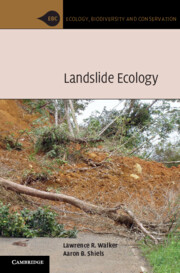1 - Introduction
Published online by Cambridge University Press: 05 January 2013
Summary
Key points
The geological characteristics of landslides and their management as physical hazards are well documented. In contrast, the ecological processes that are initiated by landslides, and their relevance to efforts to restore stability to unstable slopes, have never been synthesized.
Landslides can cause intense human suffering and human activities can aggravate natural causes of landslides. However, we can ameliorate many of the worst effects of landslides through improved prediction and restoration of landslides and adjoining slopes.
Landslides initiate many ecological processes at landscape to local scales, including the process of ecological succession. Although landslides have negative effects on the survival of many terrestrial and aquatic organisms, they also recycle nutrients and provide habitats for colonizing species.
Landslides encompass many types of gravity-driven movements of mass. A typical landslide often has material that falls, slides, and flows, thereby creating geologically and ecologically heterogeneous substrates. Landslides cause and are caused by other disturbances, an interaction that creates a disturbance regime.
Relevance of landslides
A landslide is broadly defined as a sudden mass movement of substrate downhill and occurs on sloping terrain. Landslides can be localized slumps several square meters in size or so large that they are visible from space. Why are landslides important to you? Perhaps your property or farm has been damaged by landslides, or road access to your workplace or vacation site has been blocked. Maybe your telephone, water, or electrical power services were once disrupted. Or perhaps you follow reports of landslides because your home is on a steep slope and you wonder whether or when your property will slide. Regardless of your personal experience with landslides, we demonstrate in this book that landslides are relevant at many levels, both personal and ecological. Landslides are geological events that have obvious immediate impacts on landscapes and humans, but they also provide such ecological services as nutrient enrichment of rivers and creation of new habitats for colonizing organisms unable to survive in the surrounding ecosystem. The geology of landslides and hazard management (e.g., how to minimize property losses through landslide prediction, prevention, and restoration) are well-studied, with several recent summaries of research progress (e.g., Sidle & Ochiai, 2006; Sassa et al., 2007). However, the ecology of landslides (the interaction of organisms with the landslide environment) has received surprisingly little attention, given the dramatic influences that landslides have on the environment. Less than 1% of papers published on landslides between 1970 and 2010 address ecology (Web of Science, 2011). Landslides are a severe type of disturbance because they damage or remove plants, animals, and soil organisms. Landslide habitats are therefore of interest as examples of places where plant and animal communities assemble following disturbances that leave little or no biological legacy (primary succession). These ecological responses, when better understood, can be manipulated to augment restoration efforts that have, until recently, relied largely on modifications of the physical environment such as the construction of debris dams or re-contouring of slopes. Landslide ecology can thus be compared with other disturbances that initiate primary succession (e.g., volcanoes, retreating glaciers, and floods; Matthews, 1992; Reice, 2001; Walker & del Moral, 2003; Elias & Dias, 2009). This book attempts to fill the gap in our ecological understanding of landslides by presenting the first synthesis of the widely scattered literature on landslide ecology.
- Type
- Chapter
- Information
- Landslide Ecology , pp. 1 - 17Publisher: Cambridge University PressPrint publication year: 2012

